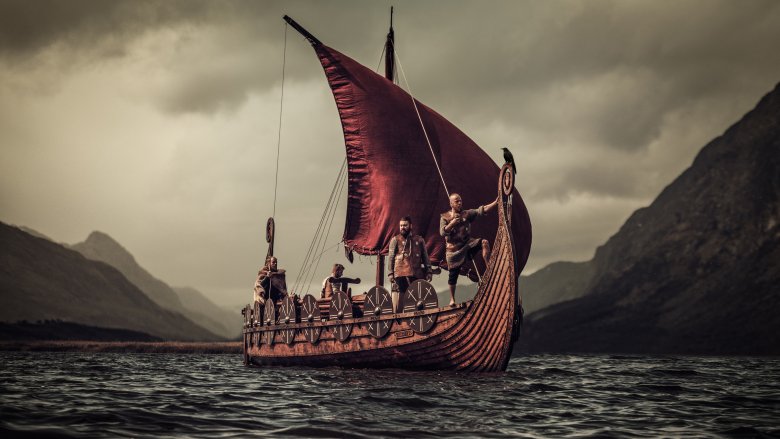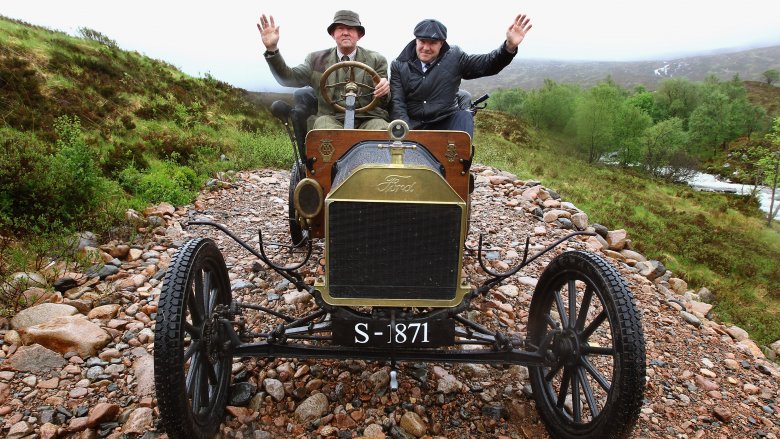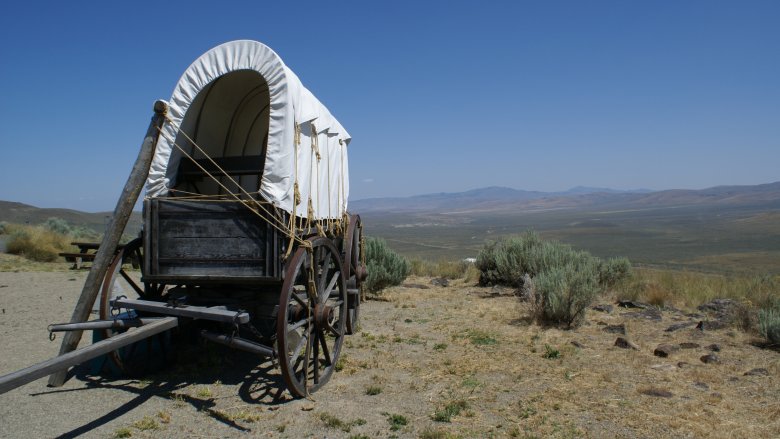Historical Events That Surprisingly Happened At The Same Time
Progress is a march forward, in a single direction. That's how we think of it anyway, so we tend to file events away in our brains in the order in which they make sense. The United States was done with all that Wild West stuff long before we had electronic technology, right? And there hasn't been an American king since we told George III what to go do with himself in 1776.
Actually, progress is a lot more zig-zaggy than that. Some of the innovations that we still depend on today first appeared centuries ago, and some things that seem really ancient still existed pretty recently. So, what we really have is a history that sometimes seems backwards and upside down, with everything happening out of order, at least based on our expectations. Here are some of the weirder historical events that shared the same time period, despite feeling like they should have happened in different centuries.
Viking raids could have been a lot more explosive
Gunpowder has blessed humanity with revolutionized warfare, cool explody things, and gender-reveal parties that end up destroying thousands of acres in southern Arizona. Where would we be without it?
Gunpowder is so pervasive in our modern world that it's hard to imagine that it has ancient origins, but it does. ThoughtCo says it was invented accidentally in China, circa 850 A.D. by an alchemist who, rather ironically, was trying to find the elixir of life. Instead, he found the elixir of killing millions of people, which is rather the opposite. His formula of saltpeter, charcoal, and sulfur exploded when exposed to flame, thus launching the era of modern warfare and hundreds of Mythbusters episodes.
Around the same time, 350 Viking ships sailed up the Thames in longboats and looted London. For the next 100 years, the Vikings clashed with the English, got ousted, resumed control, and generally made life super interesting for Londoners. It's hard to imagine that the invention of gunpowder happened at the same time that Vikings were busily killing people the old-fashioned way, but in those days it took a while for innovations to spread across continents, and Europeans didn't obtain gunpowder until the late 13th Century. Mythbusters, we think, got it in 2003.
Needles and Napoleon
Vaccinations are so modern that today, privileged white people get to pretend that they're nothing but a worldwide conspiracy to give everyone autism. But actually, vaccination is an old technique — so old, that at the time human laboratory testing was totally cool as long as it was in the name of science and the humans on the receiving end were poor kids.
According to the CDC, the world's first smallpox vaccine was tested in 1796, which was the same year that Napoleon was running around Italy pretending to be taller than he was. The vaccine was invented by Edward Jenner, who decided to turn his gardener's kid into a guinea pig. It seems he was pretty sure about his theory, but not so sure that he dared test it on anyone important or anything. He inoculated the child with material from a cowpox blister, and then exposed the poor kid to smallpox to see what would happen. Fortunately for the child — and for most of the rest of the world, with the possible exception of privileged white people — the boy appeared to be protected from the disease, and so began the end of childhood epidemics. Meanwhile, Napoleon won Italy but mostly failed in making anyone believe he was tall.
The decline of American monarchy, the ascension of escalators
Eventually, human beings realized that walking up stairs is for suckers, and the escalator was invented. What's weird about that, though, is that it happened so long ago that at the time, Hawaii was still ruled by a monarch.
If you don't count the steam-driven version (which was patented in 1859 and seems rather fraught with peril), the escalator was invented by Jesse W. Reno in 1891. According to ThoughtCo, Reno called his invention "the inclined elevator," and three years after he patented it, he built one as a Coney Island novelty ride. A few years after that, it finally dawned on the world that Reno's invention could be used to address the whole "walking up the stairs" problem, and the escalator as we know it was born.
Meanwhile, Liliuokalani was proclaimed queen of Hawaii the same year that Reno was dreaming up his Coney Island attraction. At the time, the islands were inundated with American settlers hoping to work on their tans while also getting rich from the sugar industry. Liliuokalani's predecessor had agreed to a constitution that stripped most of his power, but Liliuokalani wasn't having it. She ascended the throne as a traditional, fully autonomous monarch. Her reign only lasted for two years, though, which sort of proves that the whole idea of a western monarchy was already pretty outdated... except in the U.K. God save the queen.
Dry hops, green deserts
The dunes, the camels, the bare nothingness — the Sahara is the quintessential desert landscape, as barren as the Earth gets. That makes it especially weird to think that once, the Sahara was a beautiful, lush grassland. That must have been eons ago, right?
Actually, it was about as long ago as the invention of beer, which is a really long period of time by human thinking, but a pretty short span in geological terms. Eight thousand years ago, the Sahara was covered with grass and human beings were figuring out how to make brewski in Sumeria. So, what happened to the Sahara, and how did that magical concoction become the abomination we now know as Budweiser?
According to Popular Science, humans are to blame (for the Sahara, that is, though we don't need scientists to tell us that we can also blame ourselves for ruining beer). As humans migrated from the Nile Delta, they brought their goats and cattle with them, and the goats and cattle ripped out the grass and trampled everything that was left over.
To be fair, the beer made around that time wasn't like modern beer. Researchers think it was probably kind of sour and lacked fizz. Fortunately, beer brewing techniques had a lot of years to evolve (and devolve) into the stuff we love today.
Dammed if you do, hanged if you don't
We've been publicly executing people on television for decades... at least in fiction. Real public executions ended a long time ago, because today's humans are nothing like those crazed, bloodthirsty creatures who mobbed the gallows, throwing rotten fruit at the condemned people who marched up the steps to meet their executioner. No, modern people don't enjoy the distress of our fellow humans at all, unless we're sitting in a darkened room with a screen and some popcorn.
So, when did we stop hanging people in front of a live audience? Shockingly, it wasn't until 1936 — the same year that the Hoover Dam was completed. While the Hoover Dam is still widely considered to be one of the greatest engineering marvels in human history, the practice of public execution was a clear sign that humans were still barbarians at heart. How can one species be so paradoxical?
According to NPR, the last person unfortunate enough to be hanged in public was Rainey Bethea, who was convicted of raping a 70-year-old woman. His execution was a spectacle on par with a Black Friday sale (though the execution was probably less violent), attracting hundreds of reporters and a crowd of 20,000 people. After that, civilized societies decided that mobs should not be encouraged to enjoy the death of another human being quite so much, and public execution was banned... except for the fictional kind. Progress!
A Sunday drive through the Ottoman Empire?
The Ottoman Empire replaced the Byzantine Empire in the early 14th Century, and became one of the most successful empires in history. It spread throughout the Eastern Mediterranean to the Balkans, Hungary, and North Africa. It built a strong military, created state-run education and judicial systems, and invented the overstuffed footstool (or at least the thing that the overstuffed footstool is descended from).
It was an empire, though, and we all know from history what happens to empires. Empires fall. The Ottoman Empire was destined from the beginning to come crashing down in a cascade of shame and embarrassment, but it took 600 years for that to happen. In fact, according to the University of Central Arkansas, the Ottoman Empire was still standing when Ford unveiled the Model T in 1908.
It was the beginning of the end for the footstool-loving dynasty, though. In 1908, a group that called themselves the Young Turks rebelled against the government, and forced the sultan to adopt a constitution (or rather, re-adopt the constitution had been previously suspended because it didn't let the sultan be authoritarian enough). By 1922, the last Sultan of the Ottoman Empire fled Istanbul, paving the way for the new Republic of Turkey. Meanwhile, brand new Model T cars kept rolling off the Ford assembly line until 1927.
An institution as old as the Crusades
Even outside of the U.K., "Oxford" is a household name. It's both a dictionary and a shoe, and before that, it was a university — one of the world's most prestigious, in fact. Over the years, the university has produced 50 Nobel Prize winners, 120 Olympic medalists, 27 British Prime Ministers, and most of the world's pretentiousness. Just kidding.
Maybe Oxford's graduates have sort of earned the right to be pretentious. No university has quite such a long and noble history. In fact, the university was established at a time when being pretentious was a prerequisite for obtaining any kind of knowledge beyond how to boil water, operate a plow, and dispose of one's own excrement. According to the Oxford University website, there is evidence that teaching at Oxford began as early as 1096 A.D., which also the same year that the crusaders answered Pope Urban II's call to arms. That was the beginning stage in the first of nine violent attempts to reclaim the Holy Land and bring God's love and mercy to the non-Christian world... violently.
Oxford University and the Crusades grew up together, but by 1291, two hundred years later, the Crusades were over and 1.7 million people were dead. Oxford, as their website says, would go on to earn "the praises of popes, kings, and sages by virtue of its antiquity, curriculum, doctrine and privileges." Nope, not pretentious at all.
Fording rivers, sending faxes
The Oregon Trail is a legendary chapter in American history, that time when pioneers traveled across the untamed west in covered wagons, fighting off dysentery while relying only on their wits and their ability to type the words "pow," "bang," or "wham" without any spelling errors. Wait, that was the computer game. In real life, the pioneers didn't have to type anything, though they did die from dysentery an awful lot.
Computer-literate schoolchildren first set off down the Oregon Trail in 1974, but the real Oregon Trail pioneers left home in 1843, beginning a seemingly endless trek across prairies, along rivers, and through mountain passes. The journey would kill one in 17 people who attempted it.
Incidentally, 1843 was also the year the fax machine was patented. According to FaxAuthority (the foremost authority of faxing, as you may have guessed), inventor Alexander Bain figured out how to send an image over wire by synchronizing two pendulums through a clock, which allowed him to do a line-by-line scan of a message.
It probably won't surprise you to hear that Bain's invention didn't really catch on right away. It was improved upon over the years, but a standard for the transmission of images over distances didn't emerge until the 1980s, just a few years after the release of the first Oregon Trail video game. Coincidence? Yes. Definitely a coincidence.
When prehistory meets ancient history
The woolly mammoth is a legendary creature that once roamed ancient America. Today, they can be seen only in museums and those movies where the saber-toothed squirrel gets his butt handed to him over and over again because he can't just go look for a different acorn, already. You know, one that isn't balanced precariously on the banks of a piranha-filled lake.
Mammoths are prehistory, and the pyramids are ancient history, so those two things couldn't have happened at the same time, could they? World Atlas says they did. Now, most mammoths were extinct by the time the Egyptians were laying down those first stones, but there was still a small population living on an island in the Arctic Ocean, somewhere between Alaska and Siberia. Mammoths occupied Wrangel Island up until about 4,000 years ago. The pyramids at Giza were built roughly 4,500 years ago, so mammoths existed for a good half a millennium after that.
The Wrangel Island mammoths outlived the rest of the mammoth population by about 6,000 years, but when their island home broke away from the mainland, they were already doomed. That's because the population was small and isolated, and you don't have to be a geneticist or a fan of Deliverance to know what that means. Inbreeding contributed significantly to the decline of the Wrangel Island mammoths, and the last of them died out around the time of Egypt's king Nebhepetre Mentuhotep II.
Super Jack the Ripper Bros.
Jack the Ripper was the first serial killer to morbidly fascinate generations of amateur sleuths, novelists, and memorabilia sellers on eBay. According to Biography, Jack the Ripper had a creepily masterful knowledge of human anatomy, and despite his taunting letters to Scotland Yard, he was never apprehended. More than a century later, it's tempting to think that modern forensics could have led to the Ripper's capture. It is true that the police in 1888 didn't have DNA testing, but many of the techniques used to investigate the crimes are still used today. It was all for naught, but that doesn't mean the police weren't using reasonably sophisticated investigative techniques.
Still, we imagine early Scotland Yard being run by dudes in funny hats with giant magnifying glasses, which makes it rather shocking to hear that the Ripper investigation was still ongoing when Fusajiro Yamauchi founded the Nintendo company in Japan. To be fair, Nintendo wasn't exactly ready to launch Super Mario Bros. that year — its first product line was playing cards. Super Mario Bros. came much later, in 1985, the same year that United Entertainment released The Ripper, a gripping tale of a college professor who puts on a cool ring and then becomes possessed by the spirit of Jack the Ripper. Coincidence? No, just a really stupid movie.










